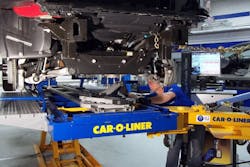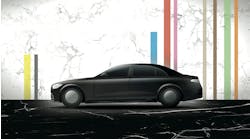Steven Feltovich has heard it before—and he sees it in the vast majority of shops he steps into as the manager of business consulting services for Sherwin-Williams Automotive Finishes.
“It’s a constant,” he says. “Shop owners will look at their numbers—they’ll look at an estimate and simply not understand how they cannot get paid properly for their repairs. Proper reimbursement is a major issue.”
And, it’s particularly true for frame work. As in-shop technology and modern equipment has provided collision repairers with new, better and (in some cases) quicker ways to make repairs, the expectations among insurers have shifted. Never mind that vehicles are more sophisticated today and require more complex repair methods, Feltovich says, shops are expected to meet—or at least, be paid according to—unrealistic expectations.
FenderBender spoke to numerous collision repair professionals in all segments of the industry for this story. All repeated the same sentiment: It is increasingly more difficult to receive what shops deem as proper reimbursement for labor on frame work.
Many broke it down specifically: It is a battle to receive insurer reimbursement that pays more than a single hour of labor time for frame work. No insurance carrier contacted for this story elected to comment.
The issue, really, extends past frame work into many facets of the repair process, says Aaron Schulenberg, the executive director for the Society of Collision Repair Specialists (SCRS). But, labor on frame work is a significant concern for shops.
Between repairers and insurers, there are clear areas of friction stemming from a lack of knowledge in regard to the requirements to putting a modern, high-end vehicle back to a crash-worthy state, Schulenberg says. Still, many of the issues occur in more traditional situations—sans jig features and advanced materials.
“Bottom line is that there are still many challenges,” he says.
There is no sure-fire way to guarantee full reimbursement on all repairs, but both Schulenburg and Feltovich say there are solutions every shop can follow to give itself a fighter’s chance.
Training or Conditioning?
Here’s a statistic Feltovich enjoys sharing with the dozens of estimating classes he teaches each year: Only 2–3 percent of all frontline shop workers—meaning owners, managers, CSRs, estimators who handle estimates and deal with customers—have received formalized estimate-writing training in the last 3–5 years.
“It’s pathetic,” he says. “This is something we track. … We get plenty of people who come in who’ve been writing estimates for 35 years, and they freak out about what they didn’t know. Well, sure, they were taught to write an estimate—35 years ago. A lot has changed, even from just three years ago.”
Without the ability to write a proper estimate, Feltovich says, there is no way to be reimbursed correctly for any part of the repair, let alone labor on frame work.
“Here’s the catch: Those people have received on-the-job-training every day, but who do you think that’s from?” he says. “Insurance adjusters. They are talking to you every day telling you how to write your estimates to fit their needs. They condition shops to write for them.”
“I know; I used to work for insurance companies, and they will take full advantage of that lack of training,” he adds. “We were masters at controlling our expenses at the expense of the body shop. … We conditioned them to be an extension of our claims department.”
One-line frame-work descriptions on estimates, failing to specify multi-dimensional pulling, not accounting for sway, twist, mash, sag, etc.—they’re all typical mistakes of poorly written estimates, Feltovich says.
“And it’s because shops have been conditioned in how to write estimates, rather than trained,” he says.
An Alarming Future
The light-weighting of vehicles and increasing prevalence of advanced materials in vehicle bodies are only going to make this issue murkier.
“It’s interesting, because as vehicles become more technologically advanced,” Schulenburg says, “the overall scope and requirement of what is considered, quote-unquote, frame and structural is expanding.”
The solution is education in what it takes to create a proper damage analysis process, which includes itemized, detailed estimates that are backed by manufacturer repair requirements.
And, as Schulenburg explains, that education must extend beyond your shop staff.
“It’s not just having the equipment and process, it’s education and training and being able to bring your staff up to speed in a way that they can then pass that knowledge along to whoever is paying for the repairs so that they understand the necessity of these charges,” he says.
There are many shops that have these processes in place that still meet resistance, Schulenburg says. But this gives them a fighting chance, and ground to stand on.
And Feltovich says that if a staff is trained, equipped and has the processes in place to do proper damage analysis and repair planning, that fight is made a heck of a lot easier. Reimbursement will always be a “back-and-forth,” he says, but shops should be knowledgeable enough to pull out ahead.




